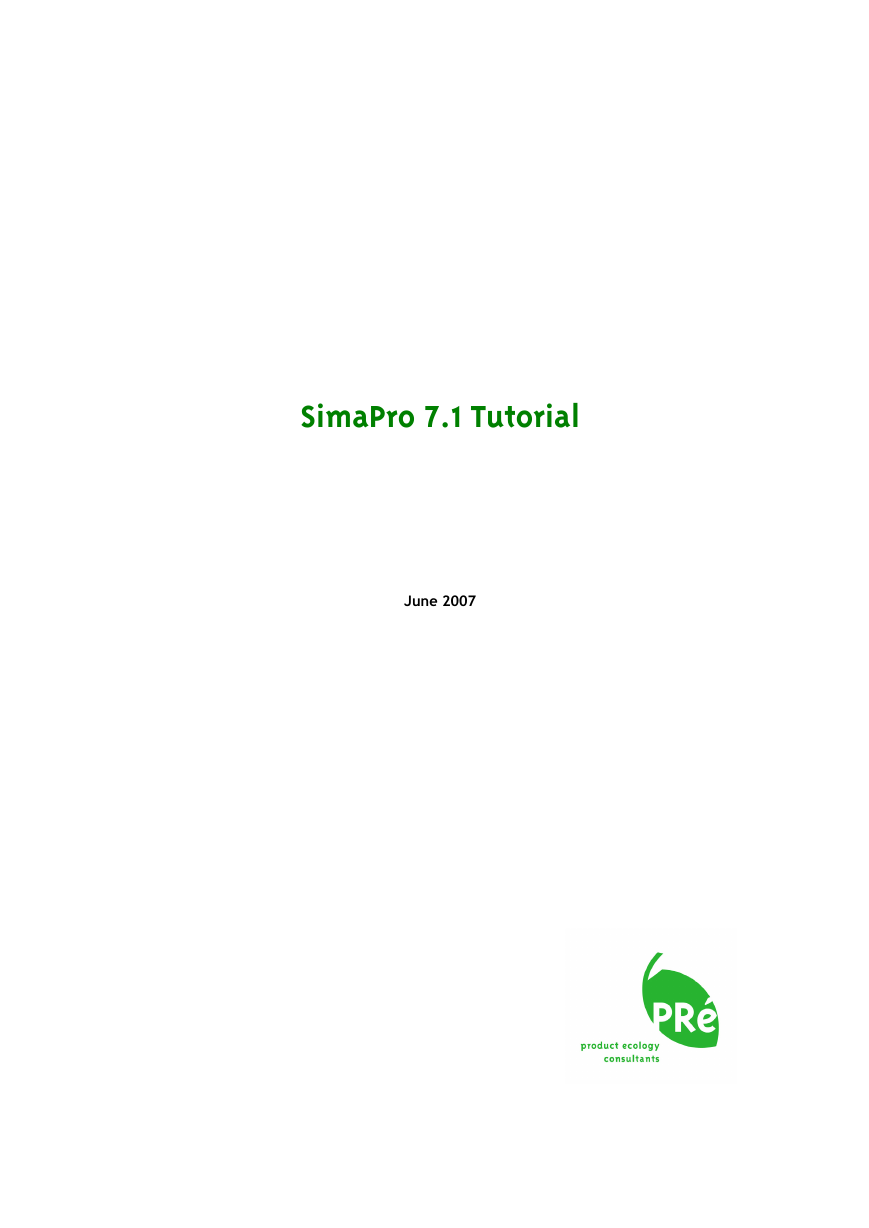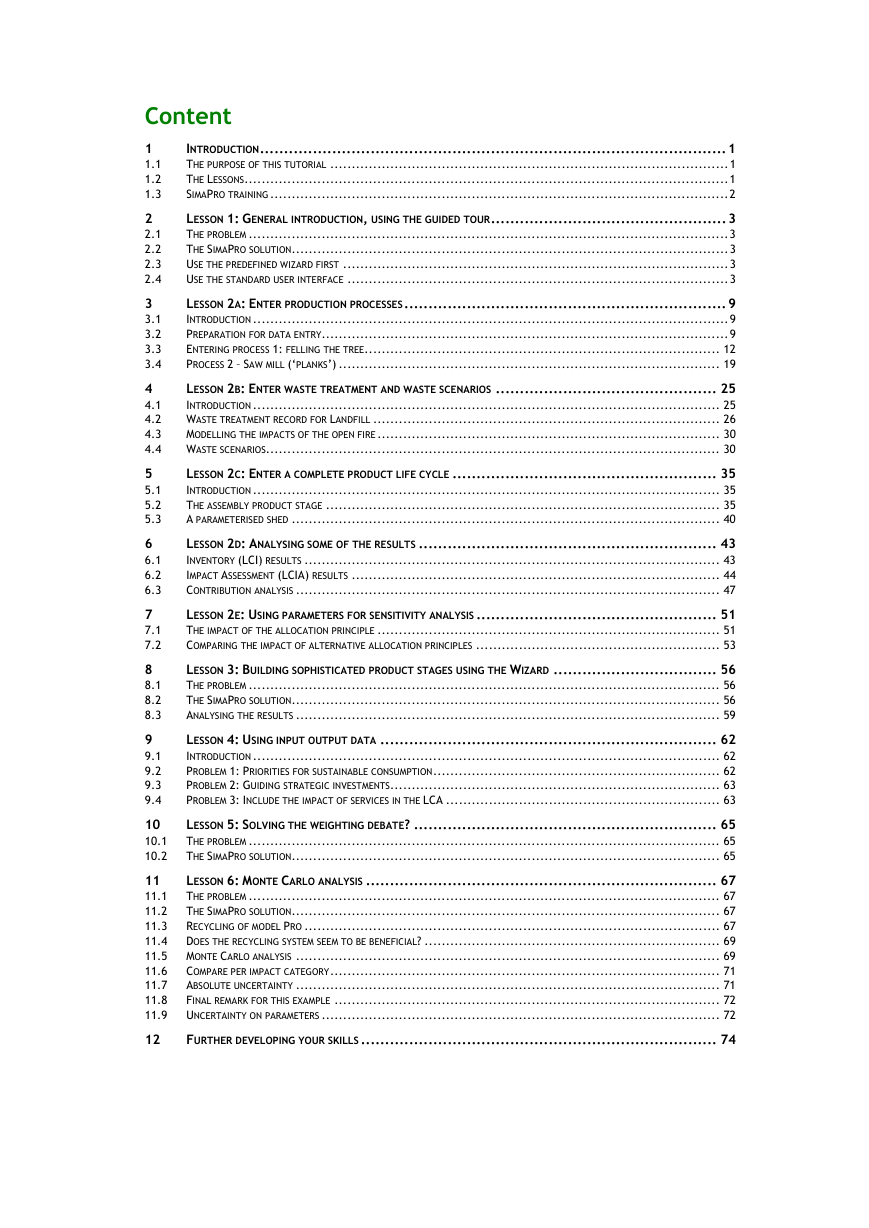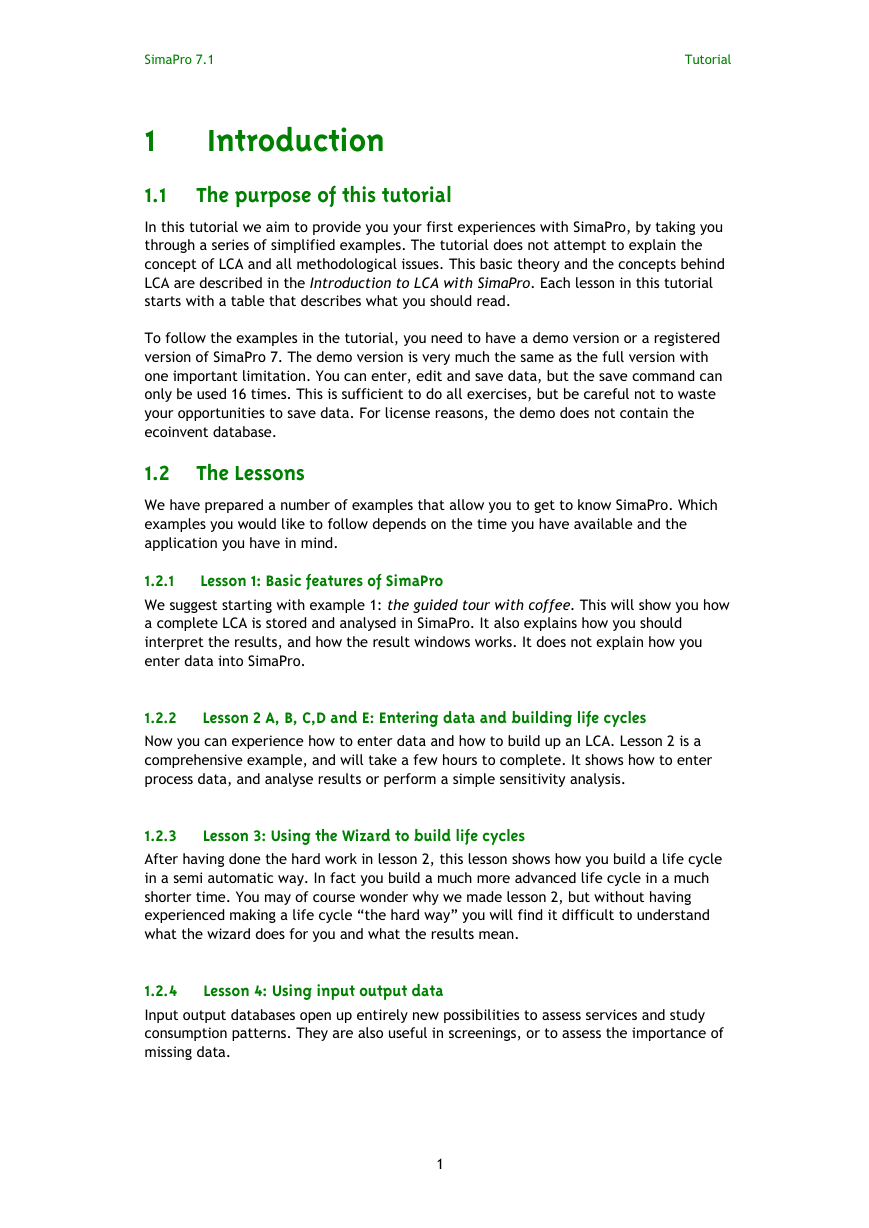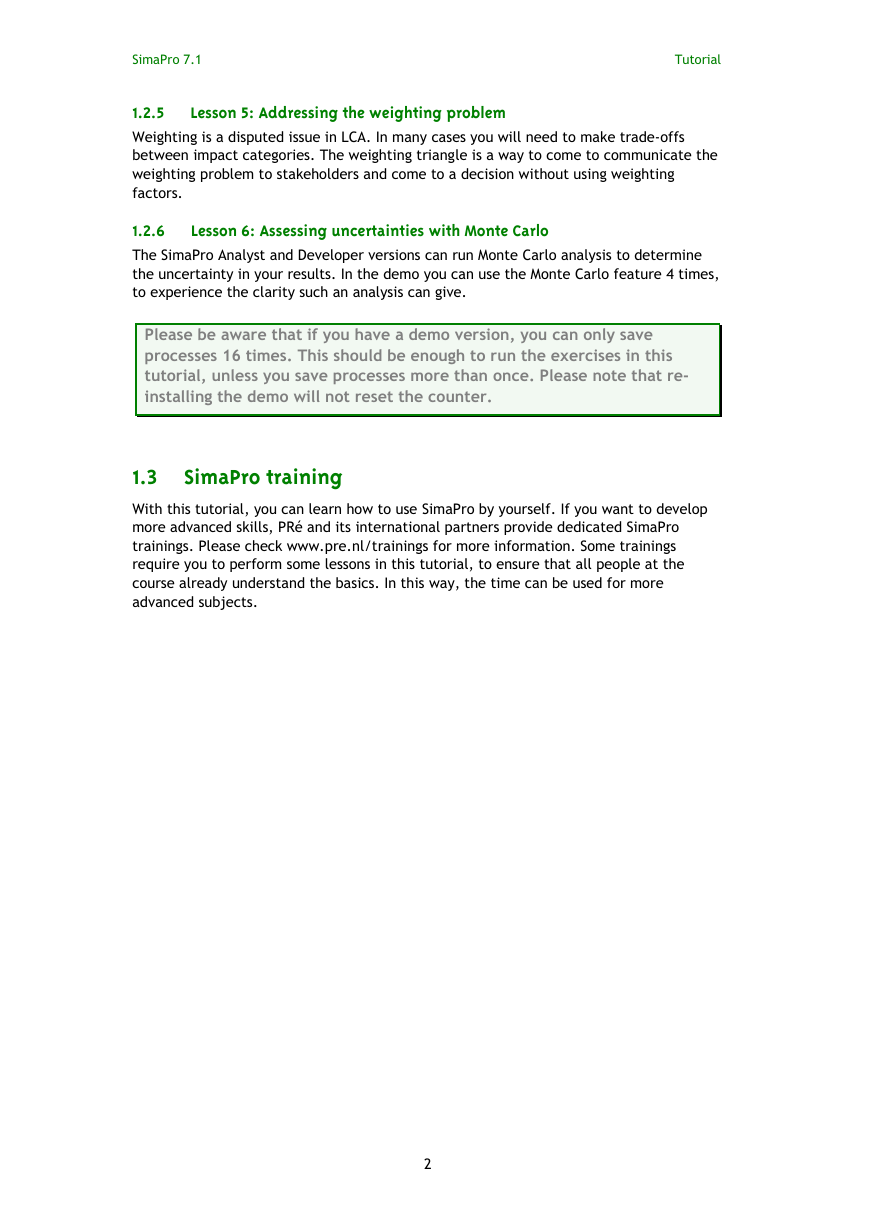SimaPro7
Tutorial
product ecology
consultants
�
SimaPro 7.1 Tutorial
June 2007
�
Colophon
Title :
Written by:
Report version:
Date:
Language:
Availability:
Copyright:
Support:
SimaPro 7.1 Tutorial
PRé Consultants
Mark Goedkoop, An De Schryver and Michiel Oele
3.2
June 2007
English
PDF file. Printed version for registered SimaPro users.
© PRé Consultants, the Netherlands. All rights reserved.
PRé Consultants grants the right to distribute and print
the unchanged PDF version of this manual for non-
commercial purposes only.
Parts of the manual may be reproduced in other work
only after permission and if a clear reference is made
that PRé Consultants is the author.
phone +31 33 4555022
fax +31 33 4555024
e-mail support@pre.nl
web site www.pre.nl
�
Content
INTRODUCTION................................................................................................. 1
1
THE PURPOSE OF THIS TUTORIAL .............................................................................................1
1.1
THE LESSONS.................................................................................................................1
1.2
SIMAPRO TRAINING ...........................................................................................................2
1.3
LESSON 1: GENERAL INTRODUCTION, USING THE GUIDED TOUR................................................. 3
2
THE PROBLEM ................................................................................................................3
2.1
THE SIMAPRO SOLUTION......................................................................................................3
2.2
USE THE PREDEFINED WIZARD FIRST ..........................................................................................3
2.3
USE THE STANDARD USER INTERFACE .........................................................................................3
2.4
LESSON 2A: ENTER PRODUCTION PROCESSES................................................................... 9
3
INTRODUCTION ...............................................................................................................9
3.1
PREPARATION FOR DATA ENTRY...............................................................................................9
3.2
ENTERING PROCESS 1: FELLING THE TREE................................................................................... 12
3.3
PROCESS 2 – SAW MILL (‘PLANKS’) ......................................................................................... 19
3.4
LESSON 2B: ENTER WASTE TREATMENT AND WASTE SCENARIOS .............................................. 25
4
INTRODUCTION ............................................................................................................. 25
4.1
WASTE TREATMENT RECORD FOR LANDFILL ................................................................................. 26
4.2
MODELLING THE IMPACTS OF THE OPEN FIRE ................................................................................ 30
4.3
WASTE SCENARIOS.......................................................................................................... 30
4.4
LESSON 2C: ENTER A COMPLETE PRODUCT LIFE CYCLE ....................................................... 35
5
INTRODUCTION ............................................................................................................. 35
5.1
THE ASSEMBLY PRODUCT STAGE ............................................................................................ 35
5.2
A PARAMETERISED SHED .................................................................................................... 40
5.3
LESSON 2D: ANALYSING SOME OF THE RESULTS .............................................................. 43
6
INVENTORY (LCI) RESULTS ................................................................................................. 43
6.1
IMPACT ASSESSMENT (LCIA) RESULTS ...................................................................................... 44
6.2
CONTRIBUTION ANALYSIS ................................................................................................... 47
6.3
LESSON 2E: USING PARAMETERS FOR SENSITIVITY ANALYSIS .................................................. 51
7
THE IMPACT OF THE ALLOCATION PRINCIPLE ................................................................................ 51
7.1
COMPARING THE IMPACT OF ALTERNATIVE ALLOCATION PRINCIPLES ......................................................... 53
7.2
LESSON 3: BUILDING SOPHISTICATED PRODUCT STAGES USING THE WIZARD .................................. 56
8
THE PROBLEM .............................................................................................................. 56
8.1
THE SIMAPRO SOLUTION.................................................................................................... 56
8.2
ANALYSING THE RESULTS ................................................................................................... 59
8.3
LESSON 4: USING INPUT OUTPUT DATA ...................................................................... 62
9
INTRODUCTION ............................................................................................................. 62
9.1
PROBLEM 1: PRIORITIES FOR SUSTAINABLE CONSUMPTION................................................................... 62
9.2
PROBLEM 2: GUIDING STRATEGIC INVESTMENTS............................................................................. 63
9.3
PROBLEM 3: INCLUDE THE IMPACT OF SERVICES IN THE LCA ................................................................ 63
9.4
LESSON 5: SOLVING THE WEIGHTING DEBATE? ............................................................... 65
10
THE PROBLEM .............................................................................................................. 65
10.1
THE SIMAPRO SOLUTION.................................................................................................... 65
10.2
LESSON 6: MONTE CARLO ANALYSIS ......................................................................... 67
11
THE PROBLEM .............................................................................................................. 67
11.1
THE SIMAPRO SOLUTION.................................................................................................... 67
11.2
RECYCLING OF MODEL PRO ................................................................................................. 67
11.3
DOES THE RECYCLING SYSTEM SEEM TO BE BENEFICIAL? ..................................................................... 69
11.4
11.5 MONTE CARLO ANALYSIS ................................................................................................... 69
11.6
COMPARE PER IMPACT CATEGORY........................................................................................... 71
11.7
ABSOLUTE UNCERTAINTY ................................................................................................... 71
11.8
FINAL REMARK FOR THIS EXAMPLE .......................................................................................... 72
11.9 UNCERTAINTY ON PARAMETERS ............................................................................................. 72
12
FURTHER DEVELOPING YOUR SKILLS .......................................................................... 74
�
�
SimaPro 7.1 Tutorial
The purpose of this tutorial
Introduction
1
1.1
In this tutorial we aim to provide you your first experiences with SimaPro, by taking you
through a series of simplified examples. The tutorial does not attempt to explain the
concept of LCA and all methodological issues. This basic theory and the concepts behind
LCA are described in the Introduction to LCA with SimaPro. Each lesson in this tutorial
starts with a table that describes what you should read.
To follow the examples in the tutorial, you need to have a demo version or a registered
version of SimaPro 7. The demo version is very much the same as the full version with
one important limitation. You can enter, edit and save data, but the save command can
only be used 16 times. This is sufficient to do all exercises, but be careful not to waste
your opportunities to save data. For license reasons, the demo does not contain the
ecoinvent database.
1.2 The Lessons
We have prepared a number of examples that allow you to get to know SimaPro. Which
examples you would like to follow depends on the time you have available and the
application you have in mind.
Lesson 1: Basic features of SimaPro
1.2.1
We suggest starting with example 1: the guided tour with coffee. This will show you how
a complete LCA is stored and analysed in SimaPro. It also explains how you should
interpret the results, and how the result windows works. It does not explain how you
enter data into SimaPro.
Lesson 2 A, B, C,D and E: Entering data and building life cycles
1.2.2
Now you can experience how to enter data and how to build up an LCA. Lesson 2 is a
comprehensive example, and will take a few hours to complete. It shows how to enter
process data, and analyse results or perform a simple sensitivity analysis.
Lesson 3: Using the Wizard to build life cycles
1.2.3
After having done the hard work in lesson 2, this lesson shows how you build a life cycle
in a semi automatic way. In fact you build a much more advanced life cycle in a much
shorter time. You may of course wonder why we made lesson 2, but without having
experienced making a life cycle “the hard way” you will find it difficult to understand
what the wizard does for you and what the results mean.
Lesson 4: Using input output data
1.2.4
Input output databases open up entirely new possibilities to assess services and study
consumption patterns. They are also useful in screenings, or to assess the importance of
missing data.
1
�
SimaPro 7.1
Tutorial
Lesson 5: Addressing the weighting problem
1.2.5
Weighting is a disputed issue in LCA. In many cases you will need to make trade-offs
between impact categories. The weighting triangle is a way to come to communicate the
weighting problem to stakeholders and come to a decision without using weighting
factors.
Lesson 6: Assessing uncertainties with Monte Carlo
1.2.6
The SimaPro Analyst and Developer versions can run Monte Carlo analysis to determine
the uncertainty in your results. In the demo you can use the Monte Carlo feature 4 times,
to experience the clarity such an analysis can give.
Please be aware that if you have a demo version, you can only save
processes 16 times. This should be enough to run the exercises in this
tutorial, unless you save processes more than once. Please note that re-
installing the demo will not reset the counter.
1.3 SimaPro training
With this tutorial, you can learn how to use SimaPro by yourself. If you want to develop
more advanced skills, PRé and its international partners provide dedicated SimaPro
trainings. Please check www.pre.nl/trainings for more information. Some trainings
require you to perform some lessons in this tutorial, to ensure that all people at the
course already understand the basics. In this way, the time can be used for more
advanced subjects.
2
�
SimaPro 7.1 Tutorial
2
Lesson 1: General introduction, using
the guided tour
Overview
What you will learn
Required entry level
Recommended reading
Project needed
Approximate time needed
Get a general overview, become familiar with the most important
result screens and terminology in SimaPro
Some basic understanding of what LCA is about. This is intended to
be your first experience with SimaPro
Introduction to LCA with SimaPro, chapter 1
Introduction to SimaPro 7
15-45 minutes
2.1 The problem
Find out what guidelines should be given to designers of coffee machines. For instance,
should they focus on material selection or energy efficiency in the use phase? Is the
consumption of paper filters important? In example 6 below, we will also investigate if it
is important to organize a take back and recycling system.
2.2 The SimaPro solution
Two coffee machines are defined, a model Sima and a model Pro, with the following
specifications:
Main material for housing
System for keeping coffee warm
2.3 Use the predefined wizard first
Start with running the “Guided tour (with coffee)” wizard. The wizard will guide you
through and give a generic overview of the capabilities of SimaPro. Take your time to
read the texts on the window. This will take about 15 minutes.
2.4 Use the standard user interface
After finishing the wizard, you can also go through the example step by step, using the
normal interface. This will help you to understand the basic features in the interface.
This part will take another 20 minutes.
Model Sima
Plastic
Thermos Jug
Model Pro
Aluminium
Hotplate
Step 1: Inspect goal and scope
2.4.1
Read the description of this fictional project under Goal and Scope
in the LCA Explorer bar, and check the DQI requirements. Under
the DQI Requirements, you specify the desired data characteristics
for this specific project.
Step 2: Inspect the processes in the database
2.4.2
Click on processes under Inventory, and inspect the range of
processes supplied in the database. Both colours in the index and
3
�
















 2023年江西萍乡中考道德与法治真题及答案.doc
2023年江西萍乡中考道德与法治真题及答案.doc 2012年重庆南川中考生物真题及答案.doc
2012年重庆南川中考生物真题及答案.doc 2013年江西师范大学地理学综合及文艺理论基础考研真题.doc
2013年江西师范大学地理学综合及文艺理论基础考研真题.doc 2020年四川甘孜小升初语文真题及答案I卷.doc
2020年四川甘孜小升初语文真题及答案I卷.doc 2020年注册岩土工程师专业基础考试真题及答案.doc
2020年注册岩土工程师专业基础考试真题及答案.doc 2023-2024学年福建省厦门市九年级上学期数学月考试题及答案.doc
2023-2024学年福建省厦门市九年级上学期数学月考试题及答案.doc 2021-2022学年辽宁省沈阳市大东区九年级上学期语文期末试题及答案.doc
2021-2022学年辽宁省沈阳市大东区九年级上学期语文期末试题及答案.doc 2022-2023学年北京东城区初三第一学期物理期末试卷及答案.doc
2022-2023学年北京东城区初三第一学期物理期末试卷及答案.doc 2018上半年江西教师资格初中地理学科知识与教学能力真题及答案.doc
2018上半年江西教师资格初中地理学科知识与教学能力真题及答案.doc 2012年河北国家公务员申论考试真题及答案-省级.doc
2012年河北国家公务员申论考试真题及答案-省级.doc 2020-2021学年江苏省扬州市江都区邵樊片九年级上学期数学第一次质量检测试题及答案.doc
2020-2021学年江苏省扬州市江都区邵樊片九年级上学期数学第一次质量检测试题及答案.doc 2022下半年黑龙江教师资格证中学综合素质真题及答案.doc
2022下半年黑龙江教师资格证中学综合素质真题及答案.doc